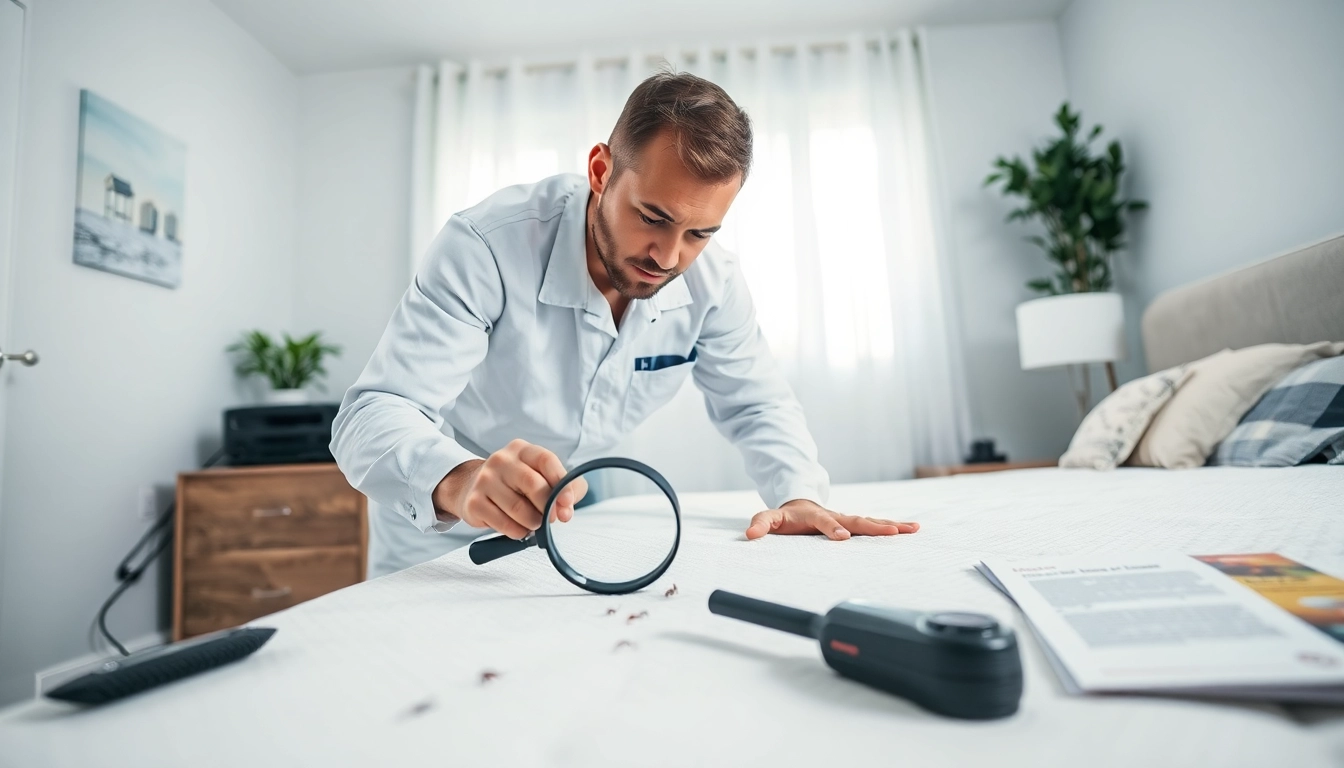Understanding Bed Bug Infestations
What Are Bed Bugs?
Bed bugs are tiny, brownish insects that feed on the blood of humans and animals, primarily at night. Measuring about one-fourth to one-half of an inch in length, these pests are known for their ability to infest homes, hotels, and other dwellings. Their flat bodies enable them to hide in small cracks and crevices, making them particularly difficult to spot until an infestation occurs. Given their proclivity for dark, secluded environments, bed bugs are often found in bedding, mattresses, and furniture.
Signs of Bed Bug Infestation
Detecting a bed bug infestation early is crucial for effective management. Some common signs of their presence include:
- Visible Bugs: Adult bed bugs can be seen with the naked eye, often in clusters.
- Fecal Stains: Small brown or black spots on bedding or furniture may indicate bed bug droppings.
- Blood Stains: Tiny blood spots on sheets or mattresses may result from crushed bugs after feeding.
- Eggs and Shells: Tiny, white eggs and shed skins are often found in hiding places.
Life Cycle and Behavior of Bed Bugs
The life cycle of bed bugs consists of several stages: egg, nymph, and adult. Female bed bugs can lay between 200 to 500 eggs in their lifetime, which hatch into nymphs that undergo several molts before reaching maturity. Unsurprisingly, the more conducive an environment is (warm, dark, and close to hosts), the more rapidly they can reproduce. Their behaviors also include nocturnal feeding habits and a penchant for reclusive environments, further complicating detection and eradication efforts.
Why You Need Bed Bug Pest Control
Health Risks Associated with Bed Bugs
Although bed bugs are not known to transmit diseases, their bites can cause various health issues. Common symptoms include redness, itching, and swelling at the site of the bite. In some cases, individuals may experience allergic reactions or secondary infections due to scratching. Furthermore, the psychological impact of living with a bed bug infestation can lead to anxiety, insomnia, and a diminished quality of life.
Economic Impact of Bed Bug Infestations
The economic repercussions of bed bug infestations can be substantial. Property owners can face high extermination costs, which often run into the thousands, especially in severe cases. Additionally, businesses, particularly in the hospitality sector, may suffer loss of reputation, reduced bookings, and expensive legal claims from affected patrons. This outcome underscores the importance of proactive pest control measures to avoid extensive damage.
Importance of Early Detection and Treatment
Early detection is paramount in managing a bed bug infestation efficiently. As bed bugs reproduce quickly, what might start as a small nuisance can escalate into a significant problem within weeks. Regular inspections, particularly after travel or new furniture purchases, can aid in early identification. Prompt treatment can reduce overall costs and minimize emotional strife.
Bed Bug Pest Control Methods
Chemical Treatments for Bed Bugs
Chemical treatments remain a primary method for controlling bed bug populations. Several classes of pesticides are used, including:
- Insect Growth Regulators (IGRs): These disrupt the life cycle of bed bugs, preventing nymphs from maturing into adults.
- Adulticides: Chemicals that target and kill adult bed bugs upon contact.
- Residual Insecticides: These remain effective over a period and can kill bed bugs that come into contact with treated surfaces.
While chemical treatments can be effective, they should be utilized in conjunction with other methods for the best results.
Non-Chemical Control Strategies
Non-chemical strategies can also be effective and are often touted as safer alternatives. These methods include:
- Heat Treatment: Exposing bed bugs to temperatures above 120°F (49°C) can effectively eradicate them, as they cannot survive heat beyond this threshold.
- Cold Treatment: Similarly, temperatures below 0°F (-18°C) can kill bed bugs and their eggs, making it a viable option in certain settings.
- Vacuuming: Regular vacuuming of infested areas can help remove bed bugs and their eggs, particularly in seams of mattresses or furniture.
Integrated Pest Management Approaches
Integrated Pest Management (IPM) represents a holistic strategy combining both chemical and non-chemical methods. It involves:
- Monitoring: Regular inspections to detect and track infestations.
- Prevention: Implementing practices to reduce pest access, food sources, and breeding opportunities.
- Control: Utilizing a variety of control methods personalized to the specific situation.
Combining these methods not only enhances effectiveness but also minimizes risks associated with pesticide use.
DIY Techniques for Bed Bug Pest Control
Home Remedies and Prevention Tips
Several DIY methods can be employed to tackle small infestations:
- Essential Oils: Certain oils, like tea tree and lavender, are believed to repel bed bugs.
- Diatomaceous Earth: This natural powder can kill bed bugs by dehydrating them when they come into contact with it.
While DIY methods might not eradicate an infestation on their own, they can complement professional treatments and help prevent future occurrences.
Effective Cleaning Strategies
Cleaning plays a crucial role in empowering DIY bed bug pest control efforts. Key practices include:
- Washing Fabrics: Wash all bedding, curtains, and clothing in hot water and dry on a high heat setting.
- Decluttering: Reducing clutter offers fewer hiding places for bed bugs and facilitates better cleaning.
- Steam Cleaning: Using a steam cleaner on carpets and upholstered furniture can also help kill bed bugs and eggs.
When to Call in Professionals
Despite your best efforts, there are scenarios where professional assistance becomes necessary. Signs that you should call in experts include:
- Widespread Infestation: If you notice bed bugs in multiple areas of your home.
- Persistent Problems: If DIY methods have proven ineffective over a reasonable timeframe.
- Lack of Time or Resources: If the infestation requires immediate attention but your schedule does not permit thorough DIY approaches.
Long-Term Maintenance After Bed Bug Pest Control
Monitoring and Inspection Techniques
After treatment, continuous monitoring is essential to ensure that bed bugs do not return. This can involve:
- Regular Inspections: Conducting monthly inspections over the initial few months post-treatment.
- Buys Monitors: These devices can be strategically placed in areas prone to bed bug activity, providing alerts when bugs are present.
Creating a Bed Bug Prevention Plan
Preventing future infestations involves planning and awareness. Consider the following strategies:
- Travel Precautions: Inspect hotel rooms for signs of bed bugs and avoid placing luggage directly on beds.
- Regular Cleaning: Maintain cleanliness through routine vacuuming and washing of linens.
- Encasement: Using mattress and box spring encasements can deter bed bugs from infesting your sleeping areas.
Resources for Ongoing Education and Support
Keeping up-to-date with bed bug information can help you remain vigilant. Utilize the following resources:
- Pest Control Websites: Reliable online platforms offer in-depth advice and resources on bed bug prevention and treatment.
- Community Forums: Engaging with others who have dealt with infestations can provide practical tips and emotional support.
- Professional Organizations: Many pest control associations provide information on best practices and training for pest control technologies and methods.
By understanding bed bugs and implementing effective Bed bug pest control methods, you can protect your home from these relentless pests. Staying informed and proactive is key to ensuring that your living space remains pest-free.


